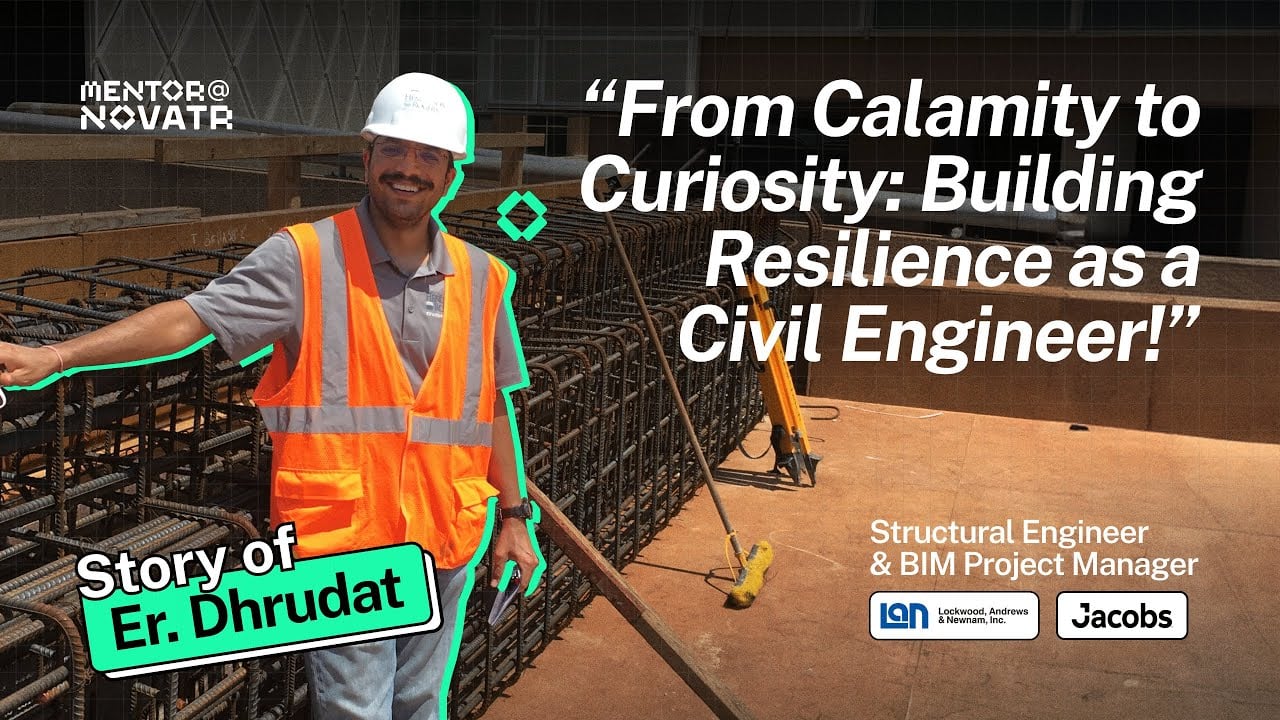
What makes a person truly resilient? The paths they’ve taken? Or the paths they let go of?
This is the story of Dhrudat Patel, a mentor at Novatr and presently working as a Senior Civil Structural Designer and BIM Project Manager at Lockwood, Andrews and Newnam, Inc. (LAN), USA, who decided to become a Civil Engineer at a very young age. His interest in the field didn’t come from the high-paying salaries or global exposure, though.
He was driven to save lives. A childhood experience—the 2001 Gujarat earthquake—shook him to the core and inspired a lifelong mission to build a better future.
Read on to know where Dhrudat started, how he decided to join the AEC industry, and what made him pick Novatr to get where he is today.
Who is Dhrudat Patel, and what did the young Dhrudat dream of being?
Growing up, my brother and I would get excited seeing planes in the sky, dreaming of becoming pilots. The 2001 Gujarat earthquake had a profound impact on me. I saw around, you know, buildings falling and the casualties. So probably that's when the seed was planted that, you know, I would like to do something where I can save humanity or conserve the resources and infrastructure that we have.
And then I would say the motivational part was my brother-in-law. When I learned about him, he was a structural engineer.
Read more: Career Guide for Structural Engineering Roles in 2025
How did you end up transitioning from Civil to Structural Engineering? How different was the experience from your Undergrad to Postgrad?
I was an average kid in civil engineering. The tipping point to structural engineering was my brother-in-law, as I mentioned. He'd explain that structural engineers decide beam and column sizes, comparing them to our human body, backbone, and bones supporting weight. This created a soft corner for structural engineering, connecting back to that 2001 event.
From Undergrad to Postgrad, a civil engineering undergrad gives you exposure to different segments each semester. It's up to you based on your interest. For Postgraduation, I chose structural engineering but kept myself open. Now practicing, I can't distinguish myself from other segments of civil engineering when dealing with construction or foundation issues.
Read More:
Career Guide: Transition from Civil Engineer to BIM Modeller
Benefits of BIM Technology for Structural Engineers
How challenging is it to find a job as a Civil Engineer? In India and the USA?
I joined Secmec for my very first formal job after my post-graduation. It was at the same company that I interned at.”
You don't necessarily need to come to the US. Amazing projects are happening everywhere—India, Africa, and the Gulf countries. We're no longer in silos where opportunities exist only in certain places. However, fancy structural designs might be more common in the US. If you're struggling to find opportunities in your location, consider moving to the US, where even small structural consulting firms work on interesting projects.
Don't just sit idly after completing your course—put your knowledge to work. Whether you're in India, the US, or elsewhere, the process may differ, but if you're passionate about working on unique structures, consider relocating to where those opportunities exist.”
In Demand Jobs and Salaries using BIM Expertise in Civil Engineering (2025)
Top 20 Structural Engineering Firms in India & the US 2025
What does a workday look like for a Structural Engineer and a BIM Project Manager?
As a structural engineer, you must cultivate and understand various parameters. I emphasise that when in school or work, I prepare for tomorrow at the end of each day by noting tasks ahead. However, I typically accomplish only about 50% of these tasks because construction issues arise, requiring immediate responses. You must adjust to client demands and industry needs, and support younger colleagues when stuck. Despite juggling client conversations, contractor discussions, mentoring young engineers, and meeting with supervisors, I maintain focus on my priorities.
How a Structural Engineer can Benefit from BIM
What inspired you to start mentoring? What’s been the most rewarding part of your journey with Novatr?
I always like to spend time with people. I used to do a lot of mentoring over here in the United States as well.
Novatr creates awareness about engineering and exposes learners to the field of Civil Engineering. I truly appreciate your efforts and support in making that happen.
How do you see the AEC industry evolving in the next decade? Any emerging trends that young professionals should focus on?
I know technology is advancing, like CDCD, which creates 3D X-rays for dental work. Similar technology is being developed for buildings. Software like Hilti, which I use frequently, allows for defining different column shapes and concrete elements. Yet we face limitations with existing structures. For example, in one project involving a zigzag pattern of columns where we needed to add structure on top, Hilti couldn't model it properly.
I think about these challenges but rarely pursue solutions due to time constraints from personal and professional commitments. Still, I always consider how to bring value and optimise processes, whether as a student or a practising engineer, without focusing on immediate rewards. Early in my career, I'd question why I should go the extra mile without recognition, but I've learned that adding value without expecting immediate rewards is important.
Top AEC Computational Design Trends in 2025
Want to learn more about the AEC industry? Watch the complete interview, and get insights from our Mentor
About the Mentor
Dhrudat Patel is a Senior Civil Structural Designer and BIM Project Manager at Lockwood, Andrews and Newnam, Inc. (LAN), USA. He is also a Novatr mentor who believes in building resilient structures and helping early-career professionals navigate the AEC industry.
Check him out on LinkedIn
Was this content helpful to you










